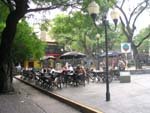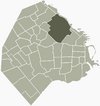This is the first polyglot blog about places & events of Palermo Viejo, the trendiest neighborhood of Buenos Aires. / Primer blog políglota sobre lugares y eventos de Palermo Viejo, el barrio más “trendy” de Buenos Aires. / Este é o primeiro blog poliglota sobre lugares e eventos de Palermo Viejo, o bairro mais “trendy” de Buenos Aires. / Premier blog polyglot sur boutiques, restaurants, hôtels et événements de Palermo Viejo, le quartier plus “trendy” de Buenos Aires, Argentina.
Places to visit in Palermo
 Check out http://www.bue.gov.ar/home/ & (http://www.palermonline.com.ar/index.html) for places to visit in Palermo. Here are some of the most important spots.
Check out http://www.bue.gov.ar/home/ & (http://www.palermonline.com.ar/index.html) for places to visit in Palermo. Here are some of the most important spots.
- Tres de Febrero Park or Bosques de Palermo: designed by French architect and landscaper Carlos Thays and inaugurated on November 11, 1875. It is one of the big green spaces in the city, with 740 acres between Del Libertador Avenue, Salguero, Rafael Obligado Avenue and Pampa St. There are marvelous lakes and every September 21, students gather to celebrate their day and the beginning of spring, while families take advantage of the spot to take walks along the lovely grounds during the entire year. You can enjoy the “Poets Garden” provided with sculptures by different plastic artists, the “Andalusian Yard” covered with trees foliage and the “Roses Garden” or Rosedal (http://www.cedom.gov.ar/es/ciudad/paseos/capitulo6_c.html) with 15,000 rose bushes and plants of 1,189 different species. The Spaniards’ Monument (or Magna Charta and the Four Regions of Argentina) by sculptor Agustín Querol y Subirats was donated by the Spanish community. It is located on Sarmiento and Del Libertador Avenues. Its materials are bronze and marble, with the final detail of the image that represents the Republic.
- Buenos Aires Zoo: on Sarmiento and Las Heras Avenues. It was created at the initiative of President Sarmiento. Since being turned over to private hands on a concession basis, this legendary city zoo has recovered its past brilliance with professional care for the specimens inhabiting it. Among the very special sights that can be seen are the white tigers, of which there are fewer than 200 specimens in the world. In addition to the impressive array and variety of species that live in spots that recreate their natural habitats, the Buenos Aires Zoo also offers specially designed spaces like the bears’ gothic pavilion; the French palace, with its slate roof, that houses the lions, or the 10,000-square-foot reproduction of a Bombay temple which is, obviously, where diverse Indian elephants reside. (http://www.zoobuenosaires.com.ar/index_fla_on.htm)
- Botanical Garden: Designed by Carlos Thays, it was inaugurated on September 7, 1898. It occupies a surface of 69,772 square meters and comprises about 5,500 shrub species, arboreal species and herbaceous species sorted by place of origin, family and use. Five green houses included. Green house number 1 has been taken from France in 1900, after being awarded at the famous Fair of Paris where the Eiffel Tower was exhibited for the very first time. The English-style central building was built in 1881. This is the place where Thays lived with his family during his last years as Director of Parks of Buenos Aires City (1892-1898). The Government of Buenos Aires City has officially declared the Botanic Garden “Carlos Thays” of Cultural Interest, as it has been considered part of the Cultural Creation of the City. At the entrance of the park, you can see an important collection of art pieces. (http://www.buenosaires.gov.ar/areas/med_ambiente/botanico/?menu_id=11360)
- Rural Society: located at one of the most important spot in the city, on Sarmiento and Santa Fe Avenues. Following the signing of the title deed to the lands where the Rural Society is located, the organization undertook an ambitious building project, which has allowed the staging of diverse contests and exhibitions. The Book Fair is sometimes held in its premises. However, the most famous offering of the Rural Society is the country’s cattle show. It is usually held in the month of July or August and is visited by people from around the country and abroad. The best of the countryside converges on this spot where awards are conferred on the champions of the Argentine farmlands. (http://www.ruralarg.org.ar/)
- Japanese Garden: Located within Tres de Febrero Park, it was created in 1967 by the Japanese community residing in Argentina. Ten years later, the landscape artist Yasuo Inomata redesigned the Garden inspired on Zen gardens that are generally located at the main entrance of temples. The garden surface occupies nearly 5 acres. There is an artificial lake that takes up 70 per cent of the whole garden, as well as several bridges and isles. The main isle is The Gods Island, where you can reach through a curved bridge or the Good Venture Bridge. The flora comprises 150 species, most of them brought from Japan. The main attractions are the Monument to the Japanese Immigrant - as homage to the founding community - and the Peace Bell used every year to celebrate the world peace day. There is an oriental restaurant and a cultural place called Tea House that offers exhibitions, shows and conferences related to the Japanese culture. Av. Casares and Av. A. Berro. (http://www.ruralarg.org.ar/)
- Palermo Chico or Barrio Parque: a residential and extremely beautiful part of Palermo, bounded by Figueroa Alcorta Avenue, between Tagle and San Martín de Tours). There are mostly two- and three-story town houses owned by TV artists and embassies.
- Museum of Decorative Arts: located in what used to be the Errázuri Palace, a prime example of the Bourbon architecture that influenced a greater part of the majestic buildings in the Buenos Aires of the early 20th century. (http://www.mnad.org/)
- José Hernández Museum of Argentine Subjects: It houses all the collections pertaining to our traditions, including all translations of “Martín Fierro.” (http://www.mujose.org.ar/)
- Malba (Buenos Aires Museum of Latin American Art: http://www.malba.org.ar/web/).
- Eduardo Sívori Museum (http://www.museosivori.org.ar/)
- The oldest part of Palermo is known, precisely, as Palermo Viejo (old Palermo) and it ranges from the rear of Plaza Italia toward the southeast. Its beginnings were as a lower-class outskirt, worthy of tango lyrics and of the pen of writers like Evaristo Carriego and Jorge Luis Borges. Within Palermo we likewise find a beautiful place, in the area next to the Basílica del Espíritu Santo or “La Guadalupe,” which was designed by the architect Juan Beckeert and is built with black marble originally from the old Vienna opera house itself. The floor tiles are German, the stained glass is French and the remainder of the marble and wood is high-quality Argentine material.
- Planetario: http://www.planetario.gov.ar/quienes.htm
- Evita Museum: (http://www.museoevita.org/)
 Check out http://www.bue.gov.ar/home/ & (http://www.palermonline.com.ar/index.html) for places to visit in Palermo. Here are some of the most important spots.
Check out http://www.bue.gov.ar/home/ & (http://www.palermonline.com.ar/index.html) for places to visit in Palermo. Here are some of the most important spots.















1 Comments:
Many thanks for your recomendations. I am staying in one of the best Buenos Aires hotels near the Alto Palermo shopping, so all you mentioned is ok for me, because someone only told me to go to Parque 3 de Febrero. I will find out how to go to all the places you mentioned!!!!!
Post a Comment
<< Home